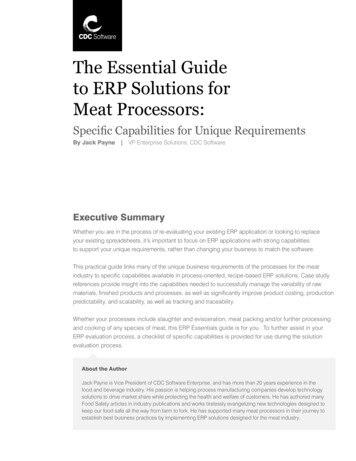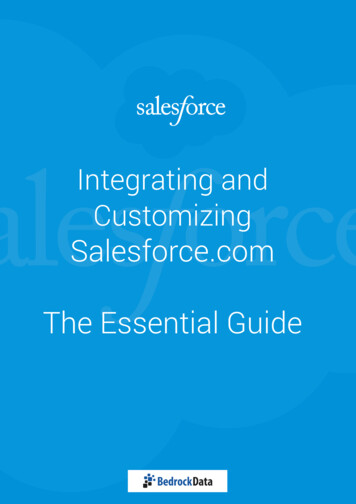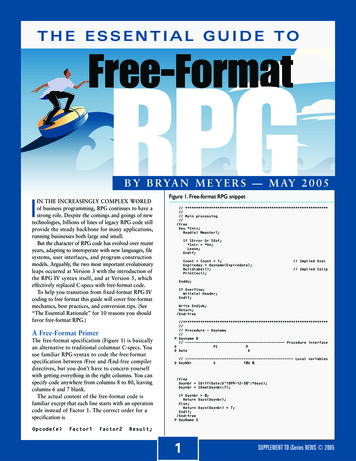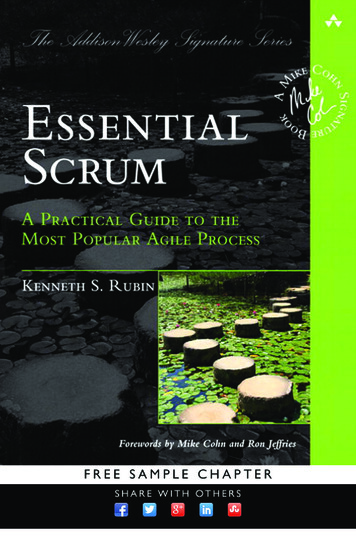
Transcription
The Essential Guideto ERP Solutions forMeat Processors:Specific Capabilities for Unique RequirementsBy Jack Payne VP Enterprise Solutions, CDC SoftwareExecutive SummaryWhether you are in the process of re-evaluating your existing ERP application or looking to replaceyour existing spreadsheets, it’s important to focus on ERP applications with strong capabilitiesto support your unique requirements, rather than changing your business to match the software.This practical guide links many of the unique business requirements of the processes for the meatindustry to specific capabilities available in process-oriented, recipe-based ERP solutions. Case studyreferences provide insight into the capabilities needed to successfully manage the variability of rawmaterials, finished products and processes, as well as significantly improve product costing, productionpredictability, and scalability, as well as tracking and traceability.Whether your processes include slaughter and evisceration, meat packing and/or further processingand cooking of any species of meat, this ERP Essentials guide is for you. To further assist in yourERP evaluation process, a checklist of specific capabilities is provided for use during the solutionevaluation process.About the AuthorJack Payne is Vice President of CDC Software Enterprise, and has more than 20 years experience in thefood and beverage industry. His passion is helping process manufacturing companies develop technologysolutions to drive market share while protecting the health and welfare of customers. He has authored manyFood Safety articles in industry publications and works tirelessly evangelizing new technologies designed tokeep our food safe all the way from farm to fork. He has supported many meat processors in their journey toestablish best business practices by implementing ERP solutions designed for the meat industry.
Addressing the UniqueRequirements of Meat ProcessorsMost ERP applications support the office needs of accounting, but when it comes to purchasing,inventory, manufacturing and sales, they do not meet the unique needs of a meat processor. Why?These ERP applications are generic, broad-based applications that support discrete manufacturingrather than food manufacturers, including meat processors.The fact is that the underlying architecture and functional capabilities of a process-oriented,recipe-based ERP application is different than that of a broad-based, bill of material basedERP application. Today, many software vendors offering these broad-based ERP applications claimto be able to support food manufacturing requirements. However, when you are evaluating anERP application, it is imperative to focus on the critical areas that distinguish these two types ofERP applications, because these critical areas support your unique requirements.Be aware that all process-oriented ERP applications are not equal, so due diligence is requiredwhen going “under the covers” of each ERP application. Simply because a package supports foodmanufacturing doesn’t mean it will support the requirements of meat processors.This practical guide examines these areas in terms of key ERP functional capabilities, data modelcharacteristics, and enabling technologies, specifically: The inventory, accountability, and management of meat, spices, and other ingredients, as well asfinished products, including co-products and by-products The ability to track and trace meat and ingredients, including co-products and by-products tosupport requirements of the USDA, GFSI, and customers in mock recalls and product recalls The ability to measure yields, scale production, and accurately cost all products The effect of standard weight, shelf life and expiration date, and variable lot characteristicson various ERP functions The impact of the ERP architecture and design on the application’s functionalityand its required IT maintenance The need to incorporate various technologies to improve visibility, collaborationand system interoperabilityTo further assist you in your ERP evaluation process, a summary of these critical areas is providedin the form of an ERP functional questionnaire to be used during software evaluations.CDC Ross ERP White Paper1
The Right Recipe for the Meat IndustryThe recipe-based design is the foundation that defines the manufacturing, yield, quality, and costingprocesses for process manufacturers, including meat processors. Each recipe defines the processor processes, material inputs and outputs, labor requirements, instructions, and quality checks.The difference amongst recipe-based ERP applications is in their definition and usage of the recipe.Advanced recipe-based ERP applications extend the recipe capability by allowing you to link multiplerecipes together to form a process specification to define the flow of all processes between inventorypoints, streamlining the planning, manufacturing, inventory and costing activities.Flow diagram of a sample recipe processIn discrete manufacturing, a multi-level bill of material (BOM) is applied to produce one finished productin its base unit of measure from one or more inputs. In meat processing, a recipe is used to produceone or more finished products in the same or different unit of measure (including expected co-productsand by-products), from one or more material inputs.In meat processing, when a meat processor chooses to employ a discrete-oriented, BOM-based ERPapplication, that processor will be challenged in these areas: Managing inventory for both catch weight and standard/net weight with dual units of measureand inventory quantities (e.g. lbs and cases) Tracking and tracing materials from supplier receipts to customer shipments Accurate tracking and costing of co-products and by-products Accurate product costing and comparison of standard/estimated cost to actual cost Tracking and comparing actual yields to standard yieldsCDC Ross ERP White Paper2
Managing larger volume of inventory transactions due to limited specification capabilities Measuring and comparing actual quality results to specification limitsWhy the challenges? An ERP application that uses a BOM simply does not properly manage the businessprocesses of a meat processor.Flexible Specifications Support Multiple ProcessesAssembly and packaging are standard processes executed by meat processors. Many ERP applicationsemploy separate multi-level BOM instructions and routing instructions to manage these processes.The use of separate files typically require additional maintenance and can increases the risk thatinstructions are out of synch, which negatively impacts production.An advanced recipe-based ERP application is capable of executing two or more processes in paralleland/or serial fashion within a single process specification. The intermediate inventory between processstages can be automatically transferred from one process stage to another in terms of both inventoryadjustments and routing. The routing instructions can be defined within the recipe to ensure the routingis in synch with the defined process stages.In the processing of a carcass or a primal cut, many meat processors have to manage multiple outputs,both co-products and by-products, following a defined disassembly process. Since only one output isproduced from a BOM, meat processors who employ a BOM-based ERP application, find themselvesperforming certain “workarounds,” such as entering negative values for BOM input quantities.Recipe-based ERP applications can properly support supply-based or disassembly production, suchas separating carcass or primal cuts into multiple outputs thanks to its capability to fully account for andcost all finished outputs. In fact, some ERP applications allow one to define all the meat processes fromSnapshot: Rochester MeatsRochester Meat Company, based in Rochester,Minnesota, provides ground beef items, steaks andpork products to the food service industry nationwide.This customer-driven company focuses on supplyingcustomized cuts of meat, chops, and other productsto meet the specific requirements of restaurants,cafeterias, and institutions.With its process-oriented ERP system, the companygains a competitive edge by being able to respond tospecial requests from customers quickly and easily. Forexample, if a restaurant chain wants to run a special ona 10-ounce steak, Rochester Meats is able to handleevery aspect of that request, from placing the order tocutting the meat to packaging and pricing.“When special pricing, trade promotions or programpackaging are required, our ERP system providesthe flexibility to meet the customer’s needs withoutcompromising efficiency,” said Allyson Maurer,Business Systems Manager. “We can focus on ourcustomer without worrying about whether or not ourERP system can handle the request.”In addition, the ERP system streamlines compliance,providing accurate, up-to-the minute information aboutwhere a specific item is located, where it originated,and where it is going. Customers gain peace of mind,so that if any problems should occur, the source can beidentified quickly and the product in question can beremoved from the supply chain. This access to criticalinformation also gives Rochester Meats an advantage inthe marketplace.CDC Ross ERP White Paper3
slaughter to further processing within one flexible recipe, which simplifies overall recipe maintenanceand reduces production errors.Advanced recipe-based ERP applications are able to streamline value added services and packagingthrough the use of flexible recipes. Recipes for slaughter, disassembly, value added services andpackaging can all be linked together, but maintained separately, in order to: Produce different finished products that are similarly packaged Produce stock for future private labeling Produce and track intermediates Avoid process specification maintenance every time packaging changes and vice versaPlanning a single- or multi-stage production job based on “rates” (i.e., quantity per unit of time)is a standard mode of production for supply and demand. For example, a hog processor employs adisassembly process that is based on the number of hogs to be processed (input-based disassembly)and records the cuts of meat and quantity of each.Flexible recipes allow meat processors to model their unique manufacturing processes in a seriesof controllable and repeatable process stages.Better Accountability Results in Better Predictability and ScalabilityPredictability and repeatability enable meat processors to accurately measure yields, standardizebusiness processes, and improve customer service levels. Predictability and repeatability are dependenton how well an ERP application can manage material and process variability and account for all rawmaterials, intermediates, and finished goods in the manufacturing process.Production jobs are predictable and repeatable in discrete manufacturing because of the low degree ofproduct variability. With a higher degree of product variability in process manufacturing, the tendency is toexpect production jobs to be highly variable, for example, no two carcasses or two primal cuts weigh thesame or produce the same yield. In fact, a recipe-based ERP application can account for and manage allraw materials and finished goods, therefore delivering a high level of predictability and repeatability.Without full accountability of all finished outputs, tracking and analyzing yields is a very difficult process.BOM-based ERP applications cannot accurately measure and track inputs to outputs. Since trackingand analyzing yields is critical to meat processors, in accurate yields can result in financial losses.Accurate Product Costing Increases ProfitabilityWithout accurate and up-to-date cost information, meat processors cannot make informed decisionson key business issues, such as product pricing strategies. Without the ability to link finished productsto customer discounts, promotional rebates, and incentives, it is difficult to determine product andcustomer profitability.CDC Ross ERP White Paper4
An advanced recipe-based ERP application can capture, assign, and compare actual and standardor estimated costs for all finished products. Proper handling of costs of both co-products andby-products is critical to accurate costing.Co-products costs may be based upon either a standard ratio of output quantities or based uponinequal market values. For example, in a meat processing organization, certain cuts of meat may beassigned a higher or lower percentage of cost based upon its market value. By-products are typicallyassigned a market value and costs applied to the multiple co-products.By capturing and analyzing the actual versus standard or estimated costs for co-products and by-products,meat companies are able to optimize processes and make better decisions on product pricing.Managing VariabilityMaterial variability is a key concern for meat processors since it impacts the consistency and quality ofthe finished product. A good indication that an ERP application may be capable of properly managingproduct variability is that the “item” or “product master” supports variable lot characteristics for both rawmaterials and finished products. An ERP application tailored to the meat industry should support userdefinable characteristics, but also contain predefined industry-standard characteristics such as grade,fat, or lean content. These product characteristics play a critical role in various processes, includinginventory management, order management, production scheduling, manufacturing management,quality management, and product costing.Managing variability starts with a purchase order for raw materials with specific characteristic requirements.At the time of receipt, these raw materials are inspected and characteristics are validated against a setof tolerances. For example, a purchase may be made for trimmings with a 60% lean content, and uponreceipt the actual lean percentage can be recorded and compared to the purchase specification.Meat processors should be able to optimize their production schedules based on characteristics orproduct groups (i.e., groups of materials with common characteristics such as species). Without properconsideration of product groups, a processor may perform an excessive number of changeovers,which negatively impacts their resource utilization, inventory levels, and unit costs.Snapshot: FiorucciFiorucci, a leading specialty meat producer, could nottag and track meat by-products and trimmings for usein its other products using its existing ERP application.The company needed a new application that wouldprovide enterprise-wide product tracking and costinganalysis so that it could account for losses in itsraw materials.“Since we did not have readily available detailedmanufacturing information, it was extremely timeconsuming to make informed decisions about theprofitability of products and customers. We had a realneed to know when and how to be profitable and thecustomer and product level, but could not access theinformation easily using our previous ERP application.Now, we are able to track products through their longcuring processes, at a granular level, eliminating allerrors related to manual processes. As a result, Fioruccihas increased overall operational efficiencies andsignificantly improved the bottom line.”Chris Maze, CFOCDC Ross ERP White Paper5
Being able to deliver products that meet customer requirements has become a necessity for meatprocessors to remain competitive in the marketplace. A certain product may be acceptable in oneprocess specification, but not in another, because its characteristics will not produce finished productsthat meet customer specifications. For example, one customer might order ground beef with a certainlean content percentage, while another customer has different requirements. With full visibility intoavailable raw material inventory and characteristics, meat processors can promise, produce, and shipfinished goods that meet their customers’ requirements.Manage Inventory to Improve ProfitabilityShelf life can be an on-going challenge for meat processors. In addition to basic inventory rotation methods(e.g., last in first out LIFO, and first in, first out FIFO), the ERP application should support additional methods,such as first expiry, first out when selecting meat and ingredients for production, based on the supplier orpacker production date. This should also be carried forward when selecting goods to ship to customers.“No inventory will be used before its time” is a philosophy shared by some meat processors. Inventoryis managed by its aging date — before, during and after production. For intermediate products that areproduced in between multiple process stages, the ERP application should be capable of automaticallyplacing this intermediate inventory on hold until its aging period has concluded, at which time the nextstage in the process is automatically initiated. An example is aging beef loins for a specified amount oftime before cutting into steaks.By ensuring that the best inventory rotation methods and quality standards of inventory are met, meatprocessors can significantly reduce customer charge-backs and improve customer satisfaction levels,as well as reducing waste from expired inventory.Great Variability Requires Greater Quality FunctionalityWith little variability in discrete manufacturing, quality decisions are usually black and white. A receivedor manufactured part either passes or fails to meet a quality check. With the high level of variabilityin meat processing, there are more shades of gray when it comes to making quality decisions.For example, the purchase of trimmings with a lean percentage of 60% may have a specification thataccepts from 59% to 64% and rejects/holds any receipt outside this range. Therefore, meat processorswho employ discrete-oriented ERP applications rather than process-oriented ERP applications typicallycannot effectively track the various quality conditions of raw materials and finished goods.Snapshot: Premium BrandsPremium Brands, a holding company for high enddeli and specialty meat producers, date codes everyindividual item to the unique requirements of eachcustomer. Special consideration must be given to theproper curing of its meats, both as ingredients andfinished products.With 39,000 sales unit ordered and 252,000 kilogramsbeing processed for shipment daily, the task is sizeable.The company is on track to slash lost revenues fromreturns by 50% in the next twelve months. This will addanother 2 to 3 % directly to the bottom-line companyperformance.”John Christiaens, Director of Information Technology“Our ERP application allocates product out of thewarehouse to ensure the best rotation of the product.CDC Ross ERP White Paper6
Quality checks of raw materials and finished goods should be able to be defined for supplier receipts,inventory, manufacturing, and customer shipments. By collecting and analyzing quality data, a meatprocessor can identify problems with raw materials, finished goods or equipment.Accelerating Product RecallsLot control is a standard ERP feature, in terms of assigning a lot number to a raw material or finishedproduct, entering a lot number during receiving or order selection, and generating a variety of reportsor queries based upon lot-related parameters.Lot traceability is a crucial ERP function that is responsible for tracking and tracing the lineage of all rawmaterials and finished products, including their characteristics and lot numbers. Due to the batch-runquantities produced in process manufacturing, a process-oriented ERP application should be capableof tracking and tracing an ingredient even if it only present in miniscule amounts such as a spice in afinished product; this is especially critical for meat processors.In many ERP applications, lot traceability is limited to an inventory snapshot, meaning information on aproduct is
CDC Ross ERP White Paper 2 The Right Recipe for the Meat Industry The recipe-based design is the foundation that defines the manufacturing, yield, quality, and costing . In addition, the ERP system streamlines compliance, providing accurate, up-to-the minute information abo











